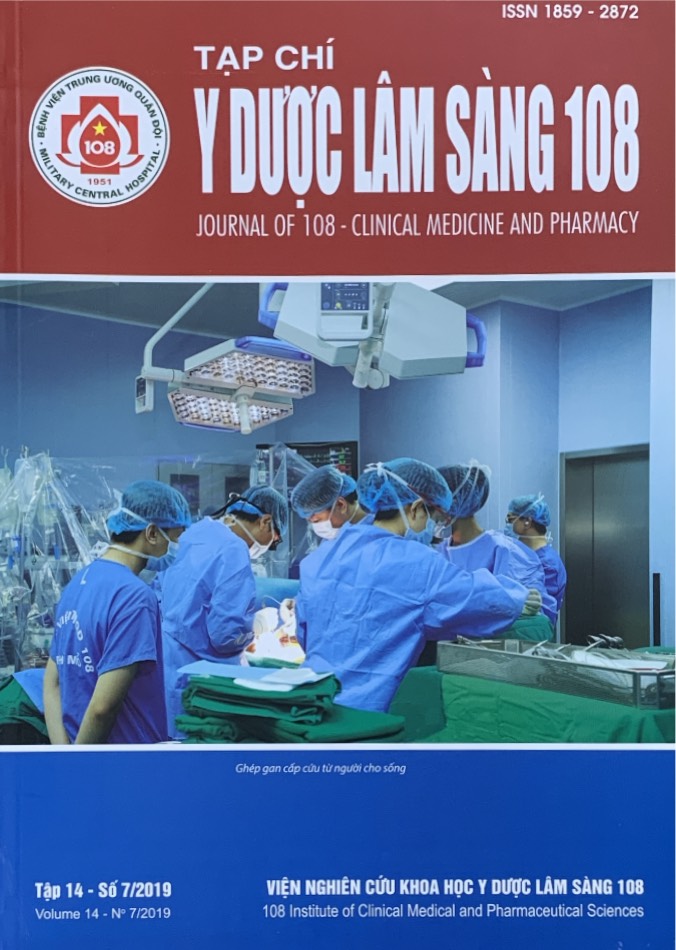Interleukin-8 in the serum of acne vulgaris patients in Dermato-Venereology Hospital of Ho Chi Minh City
Main Article Content
Keywords
Abstract
Objective: To compare the concentration of interleukin-8 (IL-8) in the serum of acne vulgaris patients with the control group. Subject and method: Case-control study, 80 patients and 80 control groups in Dermato-Venereology Hospital of Ho Chi Minh City, from 11/2018 to 9/2019. Diagnosis of acne vulgaris is based on clinical findings and severity of the disease according to the Global Acne Classification System (GAGS). Quantification of serum concentration of IL-8 by ELISA method (Enzym - Linked Immunosorbent Assay) at the Center of Molecular Biomedicine of University of Medicine and Pharmacy in Ho Chi Minh City. Data are processed by Stata 14.2 software. Result: Our sample had a higher number of females than males, the average age was 23 ± 02 years, the youngest age was 19, the oldest was 29, serum concentration of IL-8 in acne patients had 22.05 ± 49.89pg/ml, control group had 6.24 ± 8.45pg/ml. The difference was statistically significant (p<0.001). There was a statistically significant relationship between serum concentration of IL-8 and severity of the disease (p<0.05). Conclusion: The serum concentration of IL-8 in acne group was higher than the control group, the difference was statistically significant (p<0.001); there was a statistically significant relationship between serum concentration of IL-8 and severity of the disease (p<0.05).
Article Details
References
2. AI Anwar, Massi MN, Patellongi IJ, Dewiyanti W (2015) Levels of the proinflammatory cytokines: Interleukin-8, interleukin-12, tumor necrosis factor-α in severe acne at makassar. Int J Biol Med Res 6(1): 4718-4721.
3. Alicja Kucharska, Agnieszka Szmurło, Beata Sińska (2016) Significance of diet in treated and untreated acne vulgaris. Adv Dermatol Allergol 23(2): 81-86.
4. Dreno B, Gollnick HPM, Kang S et al (2015) Understanding innate immunity and inflammation in acne: Implications for management. Journal of the European Academy of Dermatology and Venereology 29(4): 3-11.
5. Beylot C, Auffret N, Poli F et al (2014) Propionibacterium acnes: An update on its role in the pathogenesis of acne. Journal of the European Academy of Dermatology and Venereology 28: 271-278.
6. Chlebus E, Chlebus M (2017) Factors affecting the course and severity of adult acne. Observational cohort study. Journal of Dermatological Treatment 28(8): 737-744.
7. Das S, Reynolds RV (2014) Recent advances in acne pathogenesis: Implications for therapy. American Journal of Clinical Dermatology 15(6): 479-488.
8. Lauren G, Jamie R, Amylynne F (2014) Perimenstrual flare of adult acne. Clinical Aesthetic Dermatology 7(8): 30-34.
9. Olga M Dеmina, Anatoly V Kartelishe, Elena I Karpova et al (2017) Role of cytokines in the pathogenesis of acne. International Journal of Biomedicine 7(1): 37-40.
10. Sabir H, Tahir I, Irfan Sadiq et al (2015) Polymorphism in the IL-8 gene promoter and the risk of acne vulgaris in a Pakistani population. Iran J Allergy Asthma Immunol 14(4): 443-449.
11. Shinjita D, Rachel V Reynolds (2014) Recent advances in acne pathogenesis: Implications for therapy. Am J Clin Dermatol 15(6): 479-488.
 ISSN: 1859 - 2872
ISSN: 1859 - 2872
